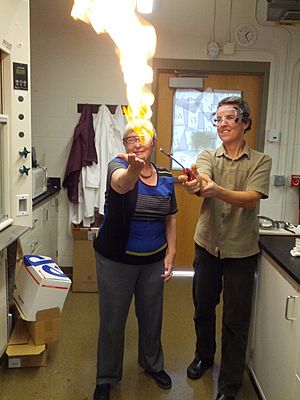Alexandra Navrotsky facts for kids
Quick facts for kids
Alexandra Navrotsky
|
|
|---|---|

Alexandra Navrotsky with Lee Penn performing the methane mamba chemical demonstration
|
|
| Born | June 20, 1943 |
| Education | Bronx High School of Science |
| Alma mater | University of Chicago |
| Awards | Member of the National Academy of Sciences |
| Scientific career | |
| Institutions | Arizona State University Princeton University University of California, Davis |
| Doctoral advisor | Ole J. Kleppa |
| Other academic advisors | Hermann Schmalzried |
| Doctoral students | Patricia Dove Nancy L. Ross |
| Other notable students | Paul F. McMillan Rebecca Lange |
Alexandra Navrotsky (born 20 June 1943 in New York City) is a famous scientist. She is a physical chemist who studies tiny materials. Her work is in a field called nanogeoscience. This field looks at how very small particles behave in the Earth.
Dr. Navrotsky is a member of important science groups. These include the United States National Academy of Sciences and the American Philosophical Society. She has won many awards for her work. These include the Urey Medal in 2005 and the Harry H. Hess Medal in 2006.
She has led big research programs. One of these is the NEAT ORU. This program studies nanomaterials in the environment, farming, and technology. She is currently a professor at Arizona State University. Her team studies how energy changes in materials. This helps us understand nanomaterials, rocks, and other materials.
Contents
Early Life and Education
Alexandra Navrotsky grew up in New York. She went to Bronx High School of Science. This school is known for its strong science programs.
After high school, she went to the University of Chicago. She earned three degrees there. She got her Bachelor's degree in 1963. Then she got her Master's degree in 1964. Finally, she earned her Ph.D. in physical chemistry in 1967. She studied with a famous scientist named Ole J. Kleppa.
Career and Research Journey
After finishing her studies, Dr. Navrotsky traveled for her research. In 1967, she went to Germany. She worked at the Clausthal University of Technology. There, she did research with Hermann Schmalzried.
She returned to the U.S. in 1968. She continued her research at Pennsylvania State University. Later, she became a chemistry professor at Arizona State University. She taught there for about five years.
In 1985, she moved to Princeton University. She worked in the Department of Geological and Geophysical Sciences. She even became the head of that department from 1988 to 1991.
In 1997, she moved to University of California at Davis. She became a professor there. She studied how ceramics, Earth materials, and environmental materials behave. From 2013 to 2017, she was a leader in the College of Letters and Sciences. Today, she is back at Arizona State University. She leads a center that studies materials in the universe.
Her main areas of study include:
- Solid-state chemistry: How solid materials are made and behave.
- Ceramics: Materials like pottery and bricks.
- Physics and Chemistry of Minerals: How rocks and minerals are formed and change.
- Geochemistry: The chemistry of the Earth.
Understanding Earth's Materials: Geochemistry
Since 1997, Dr. Navrotsky has built special equipment. This equipment measures how much energy is in materials. It works at very high temperatures. This method is called calorimetry.
She uses this method to study many types of materials. These include crystals, glasses, and tiny nanophase material. Her work helps scientists understand how materials react. This is important for both technology and understanding the Earth.
Her research also helps us learn about perovskite materials. These materials are important for understanding how planets change over time. She has shown that some materials, like zeolitic ones, have only slightly more energy than denser forms. This energy difference is linked to how atoms are connected.
Exploring Tiny Worlds: Nanomaterials
Dr. Navrotsky's research also focuses on nanomaterials. These are materials that are incredibly small. She studies how they are built and how stable they are. She also looks at how they change with temperature and pressure.
She explores how nanomaterials affect our environment. For example, she studies how they move pollutants in the air. This research helps us understand global climate change.
She once said:
Nanoparticles are everywhere. You eat them, drink them, breathe them, pay to have them, and pay even more to get rid of them.
—Alexandra Navrotsky, 2010
Awards and Special Recognitions
Dr. Navrotsky has received many awards for her important work. Here are some of them:
- Alfred P. Sloan Fellow (1973)
- Mineralogical Society of America Award (1981)
- Member, National Academy of Sciences (1993)
- President, Mineralogical Society of America (1992–1993)
- Honorary doctorate from Uppsala University, Sweden (1995)
- Benjamin Franklin Medal in Earth Science (2002)
- Urey Medal, European Association of Geochemistry (2005)
- Harry H. Hess Medal, American Geophysical Union (2006)
- Roebling Medal, Mineralogical Society of America (2009)
- W. David Kingery Award, American Ceramic Society (2016)
See also
 In Spanish: Alexandra Navrotsky para niños
In Spanish: Alexandra Navrotsky para niños

